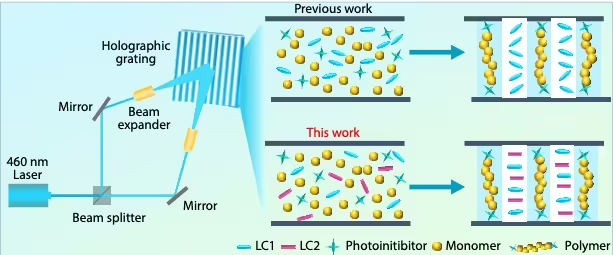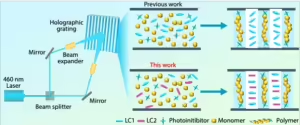Holographic polymer nanocomposites (HPNCs) have emerged as a key material in the development of advanced augmented reality (AR) devices due to their capability to create holographic optical elements (HOEs). These HOEs are crucial in reshaping light paths within AR systems, significantly impacting imaging performance and overall user experience. Unlike traditional optical elements such as prisms and mirrors, HPNCs offer a combination of design flexibility, improved optical efficiency, and the potential for thinner, lighter AR displays. Several challenges remain in engineering HPNCs that meet the demanding requirements for high-performance HOEs in AR applications.

One is achieving a sufficiently high refractive index modulation (n1), which refers to the difference in refractive index between the polymer-rich and liquid crystal (LC)-rich regions within the HPNC. A higher n1 is critical for expanding the field of view (FOV) and enhancing the diffraction efficiency of the HOEs. However, increasing the refractive index modulation often introduces optical issues such as light scattering, leading to haze, which degrades the transparency and clarity of AR displays.
Recent advancements have focused on addressing these challenges, particularly through the integration of liquid crystals into HPNCs. Liquid crystals present several advantages, including their potential to boost refractive index modulation, responsiveness to external fields, and versatile processing methods for HPNC fabrication. A significant development in this area is the incorporation of the epoxy liquid crystal E6M into polymer nanocomposites.
Researchers at Huazhong University of Science and Technology have found that adding E6M to their material achieved a refractive index modulation of 0.050 at a wavelength of 633 nm, while keeping haze low at just 5.0% with a concentration of 5%. This balance between a high refractive index (n1) and low haze is due to improved molecular ordering of liquid crystals (LCs) in the composite.
The resulting hybrid photonic nanocomposites (HPNCs) also show impressive diffraction efficiency at 96.2% with a thin layer of just 5 μm, making them ideal for compact augmented reality (AR) devices. The advances in HPNCs are expected to be transformative for AR device design delivering high optical performance with minimal thickness.
Reference
Wang, M.-Y., Zhang, Y., Wang, D., Yao, M., Wang, Y.-X., Zhou, X.-P., Peng, H.-Y., & Xie, X.-L. (2024). Holographic Polymer Nanocomposites with High Refractive Index Modulation by Doping Liquid Crystal E6M. Chinese Journal of Polymer Science, 42(7), 926–935. https://doi.org/10.1007/s10118-024-3110-z

